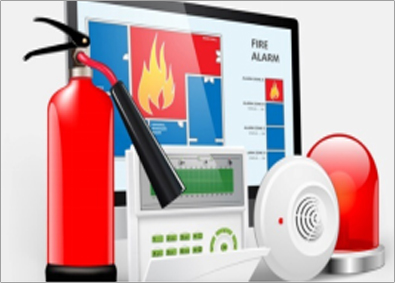Fire Alarm System
Addressable fire alarm systems are comprehensive fire detection systems capable of pinpointing not only a zone within a building where a fire may be occurring, as a conventional fire alarm system would when a fire detector is activated, but the software integrated into an addressable system enables an alphanumeric message to be displayed on the fire alarm panel indicating the precise area of the activation and therefore where a fire may be occurring.

Addressable fire alarm system
Addressable fire alarm systems are typically used within buildings where:
The risk of fire may be great
There is a complex layout
The building is deemed to be of high or historical importance
There are lone workers in isolated environments
There is a high volume of public traffic or occupancy such as in hospitals, schools,cinemas or residential care homes
Addressable fire alarm systems also have the capacity to operate multiple networked fire alarm panels, thus enabling occupants located throughout an environment to be made aware of any possible issues quickly and effectively. This networking capability enables any fire panel within an environment to be controlled from any other single panel, it also guarantees an almost unlimited amount of future expansion.
Addressable system software enables tailored solutions to suit the end-users specific requirements. For example, an addressable system within a theatre or cinema could be programmed to instigate an initial silent alarm enabling staff to investigate the issue and prevent unwarranted building evacuation due to a false alarm.
Addressable systems can be programmed to perform such functions as contacting specified alarm receiving centres, grounding lifts to prevent their use, overriding access doors and shutting down plant, e.g., air conditioning units or gas valves. These systems also enable phased evacuation from large occupancy sites.
Conventional Fire Alarm Systems
Conventional fire alarm systems are an affordable and simple method of fire detection. In the event of a fire detector being activated a conventional fire alarm system indicates a zone within the environment where fire detection activation has occurred, therefore providing the building occupants with an overview of where the fire is located. Unlikeaddressable fire alarm systems a conventional system does not pinpoint which specific fire detectors have been triggered. Conventional fire alarm systems are primarily used within small sized establishments such as:
Retail units
Dwellings
Medical centres
Offices and workplaces
Beam Detection Systems
RSD Fire Engineering specialises in the design, supply, installation and servicing of beam detection systems across all sectors. Standard beam detection is a conventional and affordable means of providing open-area smoke detection. These systems are governed by the same rulings as point detection systems in relation to the quantity and spacing requirements of detection devices, therefore it is a common misconception that beam detection systems are a 'one beam unit suits all environments' solution. Standard beam detection systems work by constantly measuring the level of intensity of a light beam projected from one location via a transmitter and receiver. Any obscuration to the light beam will initiate an alarm condition. Beam detection systems are implemented within environments containing open spaces such as:
Hospitals
Shopping malls
Stadiums
Airports
Hotels
Atriums
Warehouses
Flame Detection Systems
Flame detection system plays an important role in keeping large-sized warehouses, chemical storage area, substations safe and substantial. Since flame detectors are optical devices, they can respond to flames in less than a second. Flame detectors respond to the production of one or a combination of ultra-violet or infrared spectrums of electromagnetic radiation. These detectors are often used in situations where there is a potential for the rapid development of fire such as flammable liquids. These detectors comprise an electronic circuit with an electromagnetic radiation receiver. Flame detectors are actuated when they receive electromagnetic radiation from one or more defined wave lengths are received according to their design in the ultra-violet or infrared spectrum.
Typical applications for flame detectors are;
Wherever highly combustible materials are involved
Where there is a need for instantaneous response to flame
Wherever unsupervised areas require automated fire protection
Where there is a large capital investment to be protected
Examples of actual installations are;
Gasoline transport loading terminals
Pipeline pumping stations
Refineries
Aircraft hangers
Automotive paint spray booths
Munitions production facilities
Jet engine test cells
Offshore drilling and production platforms
Linear Heat Detection Systems
Linear heat detection (LHD) systems comprise cabling that is capable of detecting heat and triggering a fire alarm. When exposed to specific temperatures the outer covering of the cabling breaks down allowing two internal conductors to make contact and relay a fire alarm condition to the monitoring panel. Linear heat detection can integrate with both addressable fire alarm systems and conventional fire alarm systems; the location of cabling affected by the heat source can be displayed on a monitoring panel enabling identification of where a fire may be occurring. Linear heat detection systems are typically installed within the following environments:
Where conventional fire detectors cannot be used due to atmospheric conditions such as high humidity levels and air pollution
Cable tunnels
Car parks and outdoor areas
Above industrial machinery
Fuel storage areas
